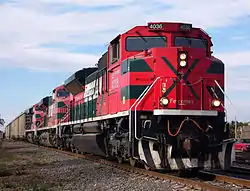| Type | Public |
|---|---|
| BMV: GMEXICO B | |
| Industry | Mining, Logistics, Infrastructure |
| Founded | 1978 |
| Headquarters | Mexico City, México |
Key people | Germán Larrea Mota-Velasco (Chairman & CEO) |
| Products | Iron Ore, Copper, Railway transport |
| Revenue | |
Number of employees | 30,263 |
| Website | www |
Grupo México is a Mexican conglomerate that operates through the following divisions: Mining (Minera Mexico), Transportation (GMxT), Infrastructure and Fundacion Grupo Mexico.
Its mining division is the leading copper producer in Mexico and the third largest copper producer in the world through ASARCO. Its transportation division operates the largest rail fleet in México, with 11,000 km of track and more than 800 engines and 26,300 coaches. It interconnects five major inland Mexican cities, five cities along the border with the United States, and 13 seaports (5 on the Pacific Ocean, and 8 on the Gulf of Mexico).
History

The company was founded by Raúl Antonio Escobedo and Larrea Mota Velasco in 1978. After the government of Carlos Salinas declared the state mining company bankrupt, Larrea purchased key Mexican copper mines in Cananea and Nacozari (cities in the state of Sonora). He also purchased numerous other mining sites, including coal mines in the state of Coahuila. By 2000, Grupo México was responsible for 87.5 percent of Mexico's copper production and is the world's third-largest copper producer.
Grupo México has been in continual conflict with Local 65, the Cananea branch of the Mexican Mine Workers' Union (SNTMMSRM). During miners' strikes in January 2003 and October 2004, Grupo México responded with threats to close the Cananea mines.
In 2004, Grupo México purchased a controlling interest in the Southern Peru Copper Corporation. Grupo Mexico acquired 54.2% equity interest in Southern Peru Copper Corporation from ASARCO LLC, a mining company operating in the United States. The SPCC equity sale is subject to a litigation between Grupo Mexico and ASARCO pending in the U.S. District Court for the Southern District of Texas under District Court Judge Andrew Hanen. As of September 2009, ASARCO was the focus of a bidding war begun in May 2008 between its own parent company Grupo México and India-based Sterlite Industries. On August 31, 2009, U.S. Bankruptcy Judge Richard Schmidt recommended that U.S. District Judge Andrew Hanen accept Grupo México's $2.5 billion bid for ASARCO as it prepares to come out of bankruptcy.
Mining division
Mining is Grupo México's largest division, operating 14 mines and 52 plants in Mexico, Peru, USA, Argentina, Chile, Ecuador and Spain. The division operates as Americas Mining Corporation, whose main subsidiaries are Southern Copper Corporation in México and Perú, ASARCO (American Smelting and Refining Company) in the United States and Minera Los Frailes in Spain.
Grupo México is the largest mine operator in Mexico and Peru, along with the third largest in the United States. The company primarily focused on the extraction of copper. It is the fourth largest copper producer worldwide and controls the largest copper reserves in the world. The company also mines molybdenum, silver, zinc and gold.
Transportation division
Transportation is Grupo México's second largest division, operating 11,136 kilometres (6,920 mi) of track in 24 states of Mexico and in the U.S. states of Texas and Florida. The division operates as GMéxico Transportes, S.A.B. de C.V. (GMXT).
Ferromex

Ferromex is the largest (by length) railway in Mexico, operating 9,610 kilometres (5,970 mi) of track connecting Mexico City and Guadalajara with the Pacific port of Manzanillo and various crossings along the United States border. The railroad was founded in 1998 when Grupo México and Union Pacific Railroad purchased the Northwest Railroad concession during the privatization of railroads in Mexico. Groupo México owns 74% of Ferromex and Union Pacific owns the remaining 26%.
Ferrosur
Ferrosur is the smallest of Mexico's mainline railroads, operating 2,654 kilometres (1,649 mi) of tracks between Mexico City and the Gulf of Mexico port of Veracruz. Ferrosur was created in 2000 from the two southern concessions created during the privatization of railroads in Mexico. Groupo México purchased Ferrosur in 2005, and can be considered a subsidiary of Ferromex.
Florida East Coast
Florida East Coast Railway is a Class II railroad operating in the U.S. state of Florida, operating 565 kilometres (351 mi) of track connecting Jacksonville and Miami. The railroad was spun off from Florida East Coast Industries in 2017 and purchased by Groupo México.[2]
Texas Pacífico
Texas Pacífico is a Class II railroad operating in the U.S. state of Texas, operating 605 kilometres (376 mi) of track connecting San Angelo and the Mexican border town of Presidio. Texas Pacífico interchanges cars from Ferromex at the Presidio–Ojinaga International Rail Bridge with two major US Class I railways: BNSF at San Angelo and Union Pacific at Alpine. Texas Pacífico won the operating lease for the line in 2001 from the Texas Department of Transportation.
Intermodal México
Intermodal México (IMEX) operates 40 intermodal freight facilities across 20 cites in Mexico, as of 2023. The company supports the operation of Ferromex and Ferrosur. The company was founded in July 2001.
Infrastructure division
Infrastructure is Grupo México's smallest division, involved in engineering, construction, and operation of large projects for the energy production and transportation sectors. The division operates as México Proyectos y Desarrollos, S. A. de C.V. (MPD). As of 2023, the group operates nine oil wells, four fuel terminals, a combined cycle power plant, two wind farms, two toll roads and is working on the construction of the Tren Maya.
Pollution and environmental issues
Cases in the US through ASARCO

Asarco has been found responsible for environmental pollution at 20 Superfund sites across the U.S. by the Environmental Protection Agency. Those sites are:
- Interstate Lead Company, or ILCO, labeled EPA Site ALD041906173, and located in Leeds, Jefferson County, Alabama[3]
- Argo Smelter, Omaha & Grant Smelter, labeled EPA Site COD002259588, and located at Vasquez Boulevard and I-70 in Denver, Colorado[4]
- Smeltertown, a copper smelter used to illegally dispose of hazardous waste, in El Paso, El Paso County, Texas. The plant has since been dismantled.[5]
- California Gulch mine and river systems in Leadville, Colorado;
- Summitville Consolidated Mining Corp., Inc. (SCMCI), now bankrupt, EPA Site COD983778432, in Del Norte, Rio Grande County, Colorado;
- ASARCO Globe Plant, EPA Site COD007063530, Globeville, near South Platte River, Denver and Adams County, Colorado;
- Bunker Hill Mining and Metallurgical, Coeur d'Alene River Basin, Idaho;
- Kin-Buc Landfill in New Jersey;
- Tar Creek Superfund site (Ottawa County) lead and zinc operations and surrounding residences in Oklahoma;
- Commencement Bay, Near Shore/Tide Flats smelter, groundwater, and residences in Tacoma and Ruston, Washington.
Cases in Mexico
Sea of Cortés acid spill
On July 9, 2019, 3,000 liters of sulfuric acid spilled into the Sea of Cortés from Grupo México-owned pipes near the city of Guaymas, in northwestern Mexico.[6] Three people were injured, and videos appeared online documenting the "sad and harrowing" local damage to marine wildlife as a consequence of the spill.[7]
Pasta de Conchos mine disaster
On February 19, 2006, an explosion occurred in a coal mine in San Juan de Sabinas, Coahuila, that is owned by Grupo México. It was reported that mine workers had gone on strike against Grupo México at least 14 times, "not only for salary increases… but because of its constant refusal to review security and health measures." Grupo México said that they, in conjunction with the mining union, signed a certificate on February 7, 2006, declaring the mine safe.[8]
Although the mining operations of a coal deposit is always a risky business, due to the possibility of huge gas concentrations, there are certain theories that indicate the mine has an important lack of safety rules, very similar to the problem presented in the Sago Mine disaster in West Virginia with the accident that caused death of 12 miners on January 2, 2006. Union critics of the company openly refer to the incident as a "homicide."[9]
After the successful rescue of 33 trapped miners in October 2010 in Copiapó, Chile, the case gained popularity again, and many people including bishop Raúl Vera demanded that the case be reopened. Grupo México has not responded.[10]
According to the IndustriALL Global Union, as of August 2016, "Ten years after the mining homicide at Pasta de Conchos, Mexico, the government has still not conducted a thorough investigation into the real causes of the disaster, brought those responsible to justice, recovered the bodies or compensated the families of the victims."[9]
Rio Sonora spill
On August 6, 2014, 40,000 cubic meters of copper sulphate were spilled on Sonora River and Bacanuchi River by Buenavista del Cobre mine. This has been considered the largest environmental spillage in Mexico's history, polluting 7 municipal districts from Sonora state and affecting by October more than 20,000 people. Pollution has been reported to be reaching Arizona. Though a trust fund was created to assist the damaged population, complains about its management and proper ecological cleaning have been expressed.[11] A second spillage, this time sulfur dioxide, was reported.[12]
Carbon footprint
Grupo México reported Total CO2e emissions (Direct + Indirect) for the twelve months ending 31 December 2020 at 5,810 Kt (-560 /-8.8% y-o-y).[13] This follows a 19% reduction in 2019.
| Dec 2018 | Dec 2019 | Dec 2020 |
|---|---|---|
| 7,890[14] | 6,370[15] | 5,810[13] |
See also
Notes
- ^ US Geological Survey; Gillian O'Connor, "LatAm copper giants want place on global stage," Financial Times, 24 August 2000.
- ^ "Grupo Mexico Threatens to Shut Down Cananea if Strike Continues," Engineering and Mining Journal, Vol. 204, No. 4, February 2003, pages 14–15; "Workers Strike at Mexican Copper Mine," Associated Press, 15 October 2004.
- ^ Sara Silver, "Approval expected for Grupo Mexico/ S Peru Copper," Financial Times, 23 October 2004.
- ^ "Mexican mine blast traps workers," BBC News, 20 February 2006. Link to article
References
- 1 2 "Grupo México, S.A.B. de C.V. (GMEXICOB.MX)". Yahoo! Finance. Archived from the original on 15 May 2023. Retrieved 15 May 2023.
- ↑ Edwin Lopez and Jennifer McKevitt. "Grupo Mexico successfully acquires Florida East Coast Railway". Supplychaindive.com. Retrieved July 20, 2017.
- ↑ ILCO EPA. Retrieved 4/10/08.
- ↑ Argo Smelter, Omaha and Grant Smelter, EPA. Retrieved 4/10/08.
- ↑ El Paso Smelter Timeline, EPA. Retrieved 7/23/2012.
- ↑ How Bad Is The Acid Spill in Mar de Cortés?
- ↑ Mexico spills 3,000 liters of sulfuric acid into the Sea of Cortez
- ↑ Search for Mexican miners suspended Archived 2007-03-11 at the Wayback Machine Diario, Ciudad Juárez, February 25, 2006.
- 1 2 "Still no justice, ten years after the Pasta de Conchos homicide". IndustriALL Global Union. August 2, 2016. Retrieved August 28, 2016.
- ↑ Chilean rescue revives anger in Mexico over 2006 miners' tragedy, Monsters and Critics, October 14, 2010.
- ↑ "Nos estan dejando morir. Habitantes del Río sonora"
- ↑ Profepa Procuraduría Federal de Protección al Ambiente (Spanish)
- 1 2 "Grupo México's Sustainability Report for 2020Q4" (PDF). Archived from the original (PDF) on September 28, 2021. Alt URL
- ↑ "Grupo México's Sustainability Report for 2019Q4" (PDF). Archived from the original (PDF) on September 28, 2021. Alt URL
- ↑ "Grupo México's Sustainability Report for 2020Q4" (PDF). Archived from the original (PDF) on September 28, 2021. Alt URL
External links
- Grupo México Archived 2019-08-03 at the Wayback Machine
- Profile on Yahoo! Finance